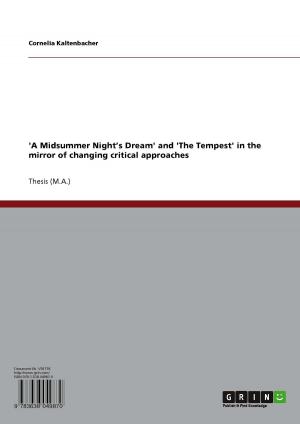Modernism in 'The Day of the Locust' (1939) by Nathanael West
Nonfiction, Entertainment, Drama, Anthologies| Author: | Linda Schug | ISBN: | 9783638444514 |
| Publisher: | GRIN Publishing | Publication: | December 2, 2005 |
| Imprint: | GRIN Publishing | Language: | English |
| Author: | Linda Schug |
| ISBN: | 9783638444514 |
| Publisher: | GRIN Publishing |
| Publication: | December 2, 2005 |
| Imprint: | GRIN Publishing |
| Language: | English |
Seminar paper from the year 2003 in the subject American Studies - Literature, grade: 1,7, University of Frankfurt (Main), course: Decadence and Moderism in the Late 20th Century American Cinema, 22 entries in the bibliography, language: English, abstract: Jonathan Veitch asserts in the preface of his book American Superrealism that critics have had problems in placing Nathanael West within the literature of the 1930s and American literature in general. They understood him for example as 'a poet of darkness', as 'an apocalyptic writer', as 'a homegrown surrealist', as 'a writer of the left' , as a 'universal satirist' , in a way as 'the prototype of the contemporary Jewish-American novelist' (Wisker 1-2) or as a realistic writer (Martin, see Roberts). Although some of these characterizations are contradictory, they all fit because they reflect different facets of the author, or rather his work. West combined all these elements and probably even several others in his writings. His 'style was never constant. At times his pictorial technique closely resembles collage [but also] cartoon strips, movies, and several different schools of painting, as well as such non-graphic visual arts as the tableau and the dance.' (Reid 9) Taking the (though not planned) final result of his development as a writer, his last book The Day of the Locust (1939) as an example, I want to show in my essay that at least one of West's books does not 'fall between the different schools of writing' (Wisker 2), as he once noted. He is certainly a representative of modernism, the 'literary movement' and 'point of view' of his time (see O'Conner) not only because a 'struggle for definition is part of what those years are about' (Wisker 121). Nathanael West was influenced by the same historical events and used many of the strategies other contemporary writers employed to express his way of seeing the world. I will point out the features of modernism in the novel because, as Randall Reid states, '[i]n a century which has made experimental writing almost an absolute value, he is one of the more interesting innovators. [...]' First of all, it will be useful to look at the historical background to understand modernism before defining it with emphasis on decadence as a special characteristic. In the next part of my essay, I am going to show how modernism, that is surrealism, Dada and the typical modernist themes, is reflected in the novel. Finally, I will summarize the resulting main points in the conclusion.
Seminar paper from the year 2003 in the subject American Studies - Literature, grade: 1,7, University of Frankfurt (Main), course: Decadence and Moderism in the Late 20th Century American Cinema, 22 entries in the bibliography, language: English, abstract: Jonathan Veitch asserts in the preface of his book American Superrealism that critics have had problems in placing Nathanael West within the literature of the 1930s and American literature in general. They understood him for example as 'a poet of darkness', as 'an apocalyptic writer', as 'a homegrown surrealist', as 'a writer of the left' , as a 'universal satirist' , in a way as 'the prototype of the contemporary Jewish-American novelist' (Wisker 1-2) or as a realistic writer (Martin, see Roberts). Although some of these characterizations are contradictory, they all fit because they reflect different facets of the author, or rather his work. West combined all these elements and probably even several others in his writings. His 'style was never constant. At times his pictorial technique closely resembles collage [but also] cartoon strips, movies, and several different schools of painting, as well as such non-graphic visual arts as the tableau and the dance.' (Reid 9) Taking the (though not planned) final result of his development as a writer, his last book The Day of the Locust (1939) as an example, I want to show in my essay that at least one of West's books does not 'fall between the different schools of writing' (Wisker 2), as he once noted. He is certainly a representative of modernism, the 'literary movement' and 'point of view' of his time (see O'Conner) not only because a 'struggle for definition is part of what those years are about' (Wisker 121). Nathanael West was influenced by the same historical events and used many of the strategies other contemporary writers employed to express his way of seeing the world. I will point out the features of modernism in the novel because, as Randall Reid states, '[i]n a century which has made experimental writing almost an absolute value, he is one of the more interesting innovators. [...]' First of all, it will be useful to look at the historical background to understand modernism before defining it with emphasis on decadence as a special characteristic. In the next part of my essay, I am going to show how modernism, that is surrealism, Dada and the typical modernist themes, is reflected in the novel. Finally, I will summarize the resulting main points in the conclusion.















